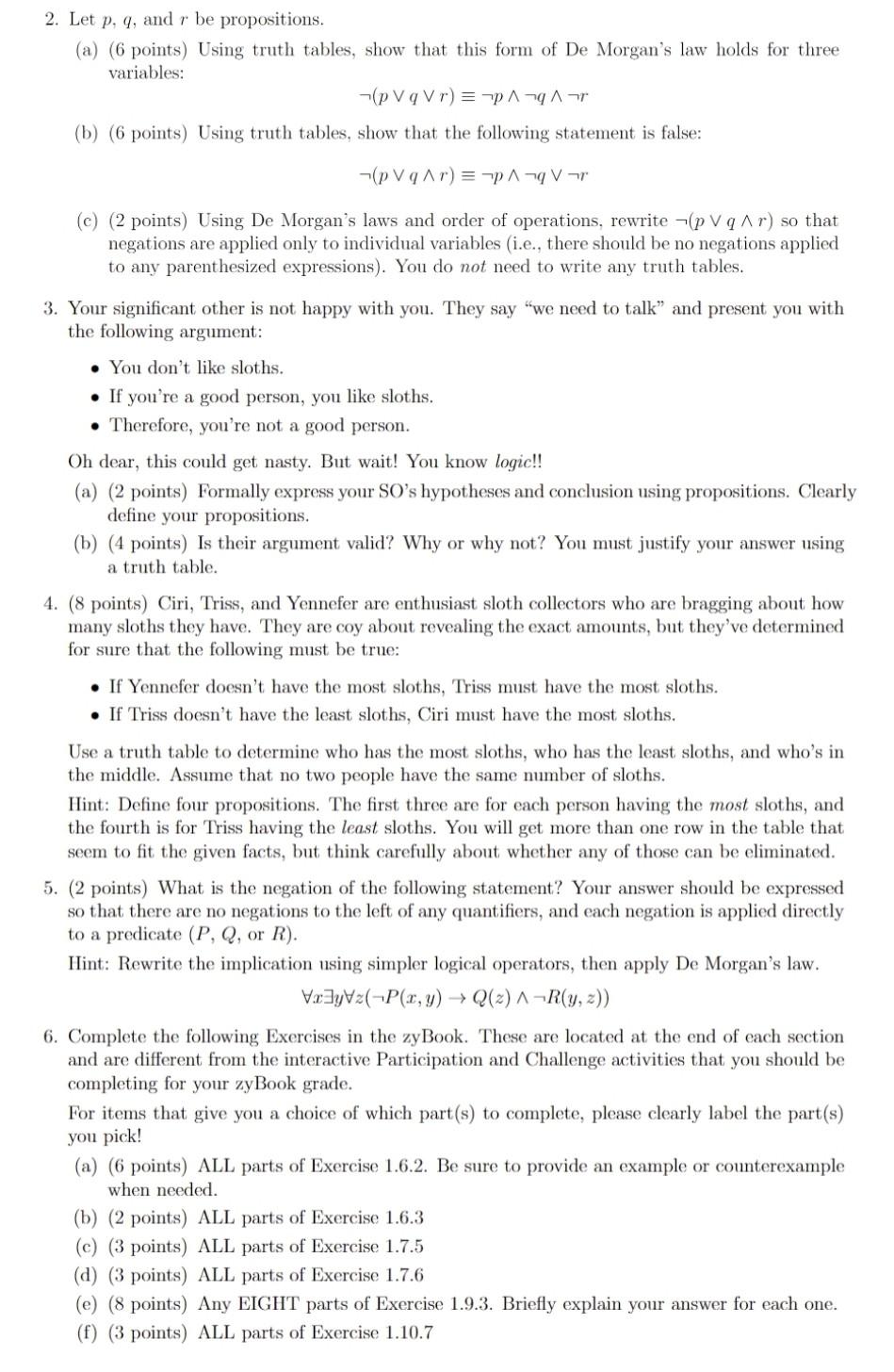Answered step by step
Verified Expert Solution
Question
1 Approved Answer
2. Let p, q, and r be propositions. (a) (6 points) Using truth tables, show that this form of De Morgan's law holds for three

2. Let p, q, and r be propositions. (a) (6 points) Using truth tables, show that this form of De Morgan's law holds for three variables: (PVqVr) = 14 (b) (6 points) Using truth tables, show that the following statement is false: (PVqAr) = AVT (c) (2 points) Using De Morgan's laws and order of operations, rewrite -(pVqAr) so that negations are applied only to individual variables (i.e., there should be no negations applied to any parenthesized expressions). You do not need to write any truth tables. 3. Your significant other is not happy with you. They say "we need to talk and present you with the following argument: You don't like sloths. If you're a good person, you like sloths. Therefore, you're not a good person. Oh dear, this could get nasty. But wait! You know logic!! (a) (2 points) Formally express your SO's hypotheses and conclusion using propositions. Clearly define your propositions. (b) (4 points) Is their argument valid? Why or why not? You must justify your answer using a truth table. 4. (8 points) Ciri, Triss, and Yennefer are enthusiast sloth collectors who are bragging about how many sloths they have. They are coy about revealing the exact amounts, but they've determined for sure that the following must be true: If Yennefer doesn't have the most sloths, Triss must have the most sloths. If Triss doesn't have the least sloths, Ciri must have the most sloths, Use a truth table to determine who has the most sloths, who has the least sloths, and who's in the middle. Assume that no two people have the same number of sloths. Hint: Define four propositions. The first three are for each person having the most sloths, and the fourth is for Triss having the least sloths. You will get more than one row in the table that seem to fit the given facts, but think carefully about whether any of those can be eliminated. 5. (2 points) What is the negation of the following statement? Your answer should be expressed so that there are no negations to the left of any quantifiers, and each negation is applied directly to a predicate (P, Q, or R). Hint: Rewrite the implication using simpler logical operators, then apply De Morgan's law. VadyVz(-P(x,y) Q(2) A-R(y,z)) 6. Complete the following Exercises in the zyBook. These are located at the end of each section and are different from the interactive Participation and Challenge activities that you should be completing for your zy Book grade. For items that give you a choice of which part(s) to complete, please clearly label the part(s) you pick! (a) 6 points) ALL parts of Exercise 1.6.2. Be sure to provide an example or counterexample when needed. (b) (2 points) ALL parts of Exercise 1.6.3 (c) (3 points) ALL parts of Exercise 1.7.5 (d) (3 points) ALL parts of Exercise 1.7.6 (e) (8 points) Any EIGHT parts of Exercise 1.9.3. Briefly explain your answer for each one. (f) (3 points) ALL parts of Exercise 1.10.7
Step by Step Solution
There are 3 Steps involved in it
Step: 1

Get Instant Access to Expert-Tailored Solutions
See step-by-step solutions with expert insights and AI powered tools for academic success
Step: 2

Step: 3

Ace Your Homework with AI
Get the answers you need in no time with our AI-driven, step-by-step assistance
Get Started


